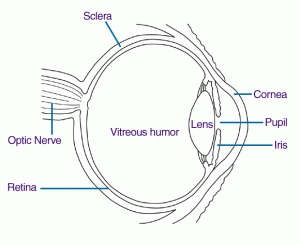Lens Implants
LENS IMPLANT PROCEDURES
Lens implants have been around for years – they are used in cataract surgeries after removal of the human lens to replace the refractive power lost by that removal (otherwise post-cataract patients would require ridiculously thick glasses).
Surgeons have become so skilled in calculating implant power that usually a post-cataract patient’s distance vision is close to perfect, assuming there is little pre-operative astigmatism. We have also been recommending lens implants for patients with prescriptions too high for LASIK for some time now, regardless of whether or not a cataract is present.
There are even toric implants now available for patients with significant astigmatism. Quite often the patient’s distance problem could be eliminated following implantation; unfortunately, without fail they would still need glasses to read and for computer use if they are over forty years old.
What if we could come up with a way to correct both the patient’s distance AND near vision, thus completely eliminating the need for any spectacle correction after surgery? Understand that until now, the reason a patient receiving a lens implant required a post-operative reading prescription is because we require our biological lens to change thickness and focus for us up close – without it, we lose that ability.
The concept of a multifocal implant was debated and researched, and has now become reality. There are currently five main implant designs:
1.Crystalens – the first available
2.ReSTOR
3.ReZoom
4.Tecnis
5. PanOptix Trifocal – the newest and the go-to since early 2020
Early in 2017 the FDA approved the ReStor toric implant, giving patients with astigmatism one of their first multifocal implant options. The newer PanOptix is also available in toric. Of course, the optimal design for any given patient is best decided between the patient and their surgeon.
How do the new multifocal implant procedures compare to LASIK?
Pros:
No after-surgery readers for most patients
- Corrections for higher prescriptions
- Patient will never have cataracts
- Thinner corneas no problem
Cons:
- More invasive procedure translates to slightly more risk of infection or trauma
- More expensive
- Possible long-term haloing at night, more so than with LASIK
We will generally tell patients who are considering refractive surgery, and want to know which procedure would be best for them, the following:
If you do not mind the idea of only reading glasses after forty and beyond, consider LASIK. It is more affordable, less invasive, and extremely accurate. If you have the attitude of “if I spend all that money, I better not need glasses for anything after the surgery,” then the implant procedures are the only game in town – and there is still a 8-10% chance you will occasionally need readers.
NOTE: Some vision insurance providers have benefits towards these procedures which can affect the cost or even cover a portion of the facility fees. Please call for a consultation with one of our doctors.


